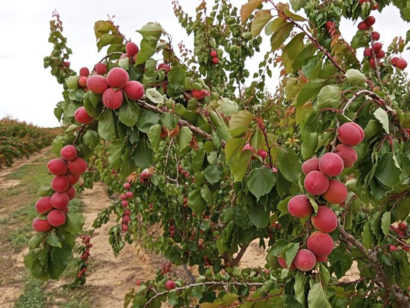The late frosts have led to shortfalls in the apricot crop in all parts of Europe.
Italy started the apricot season about 5 weeks ago in southern Italy. As several varieties ripened at the same time, an abundance of produce was noted at first, but evened out already 2 weeks later. The harvest in northern Italy is now also in full swing. On average, just under 20-30% of the produce is missing in the south and about 30-40% in the north. The decisive factor here is where exactly the apricot is grown. The fields in the valleys are more affected by the late frosts than the fields in the hills around Modena and Bologna.
The consistently high quality level of all varieties was a welcome reason for KÖLLA to market the produce under its own brand OTELLO. In the south, KÖLLA has been packing the beautifully coloured apricots in the popular and eye-catching OTELLO paper carrier bag already for a fortnight. Both in the supermarkets and in the wholesale markets, interest is very high and demand is correspondingly good. Overall, the apricots have an extremely sweet taste though some varieties have a pleasant sour undertone. Supply and demand are currently balanced and the price level remains stable.
Spain also suffered a 30-40% reduction in production, with Murcia and Aragon being hit hardest by the frosts in January and March. In Lérida, the drop in volume could be compensated slightly by new plantings, so that the shortfall should level at around 25%.
In the first third of the season, quality was still a bit of a challenge for producers, especially in the Murcia region. In the course of June, however, it improved considerably, so that in July producers are expected to provide exceptional quality….as long as the weather plays along.
For the bicoloured apricots the varieties Cot, Flodea, Orange Rubi and Big Red are harvested, for the red apricot it is the variety Rubingo.
From week 23, the varieties Samurai and Kyoto were added and from week 25 Faralia, Farely, Farbaly and Fardao will follow. From the end of August/beginning of September, the range will be rounded off with the popular Carmingo and Farlis varieties.
France was also strongly affected by the heavy frosts of spring. Producers are expecting a 43% reduction of production this year (compared to last year), with a very modest harvest already in 2020.
In the Gard, the Crau and Perpignan, harvest losses make up between 10 to 50 percent. The Rhone Valley and some southern regions have been hit particularly hard, with losses of 90% or more.
The harvest is currently starting with the Orangered, Big Red and Lido varieties, for which at least higher prices can be expected. This is followed by the varieties Kioto, Bergarouge and Faralia.
The main variety Bergeron, however, is completely absent in the second half of the season. At the end of August/beginning of September, the late varieties such as Farclo, Fardao, Farlis and others are still expected.
Even though volumes have suffered, the good qualities of French apricots keep prices at a steady level.
June 2021


